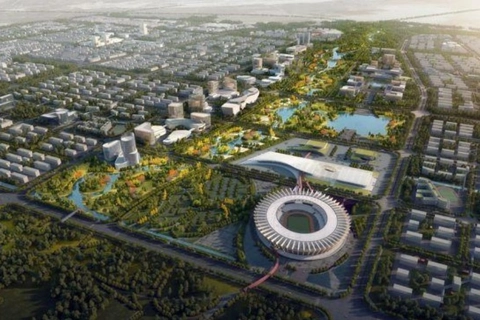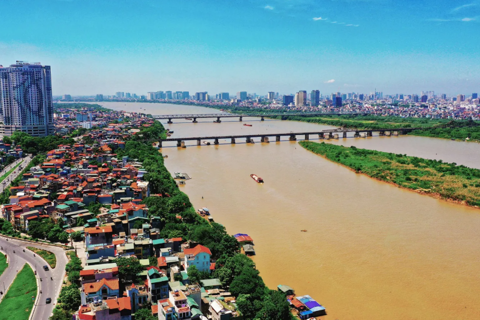Hanoi builds more craft industry clusters to reduce pollution
Industrial clusters are a prerequisite for localities with traditional handicraft villages in Hanoi.
“Having spent almost my life in my hometown, I am now so happy to see the green countryside after the polluted factories have been moved to the newly-built industrial cluster as planned. Fresh air has been absent in my village for many years because of the dust and noise emitted by wood factories located in residential areas,” Tran Thi Bach, 60, a local in Hanoi’s outlying district of Dan Phuong, told The Hanoi Times.
She added that this is the positive result of Hanoi’s policy of building industrial clusters in craft villages in recent years, making an important contribution to reducing environmental pollution.
Dan Phuong District, about 20 kilometers west of downtown Hanoi, has begun the construction of three industrial clusters in the artisan villages of Lien Trung, Lien Ha, and Dan Phuong since 2022.
The Ho Dien Industrial Cluster in Lien Trung Commune is helping the village get a facelift. Photo: Anh Kiet/The Hanoi Times |
“For decades, people in the woodworking village of Lien Trung Commune, Dan Phuong District, have lived in fear because of environmental pollution caused by wood factories near our homes, which has disrupted our daily lives,” Bach said.
She added that wood factories have not been properly managed, resulting in air, water, noise pollution, and dust spreading into the air over a wide area, seriously affecting people’s health and lives.
“In 2023, polluting timber factories were dismantled and relocated to the newly-built industrial cluster, restoring the village’s environment. Our children and grandchildren have a larger and safer place to play as the old factories have been re-purposed as cultural spaces for the community,” Bach added.
The Ho Dien Industrial Cluster brings together woodworking workshops in Lien Trung Village, away from densely populated areas. Photo: Anh Kiet/The Hanoi Times |
"However, there are still some polluting workshops that have not been relocated. I hope they will leave as soon as possible to ensure the living environment for all locals," Bach stressed.
Speaking to The Hanoi Times, Nguyen An Son, Chairman of the People's Committee of Lien Trung Commune, said that people have long used their homes as production workshops, but now if they have to move to the industrial cluster, they would have to pay for land rent, factory construction costs, and deal with many problems that arise.
“These are the barriers that discourage many workshop owners. We will be more drastic in communicating with people to relocate their production households. For the sustainable development of the commune, we are determined to deal with any violations promptly," Son said.
Ho Dien Industrial Cluster helps improve the environmental quality of Lien Trung Village. Photo: Anh Kiet/The Hanoi Times |
Nguyen Thac Hung, Vice-chairman of the Dan Phuong District People's Committee, said that the district authorities have dealt with more than 90 infringement cases on an area of 2.44 hectares. As of mid-November 2023, another 30 cases of illegal violations have been resolved.
"The enforcement confirms Dan Phuong District's strong determination to protect the environment. The three industrial clusters in the district have been operating in a stable manner, contributing to solving the problem of environmental pollution, increasing the income of thousands of workers, and creating sustainable budget revenues," Hung told The Hanoi Times.
In 2023, Hanoi's suburban district of Thanh Oai also built three industrial clusters, namely Thanh Thuy, Phuong Trung, and Hong Duong. Covering an area of 17.14 hectares, the industrial clusters are expected to attract more than 100 enterprises and create jobs for about 3,000 workers, said Nguyen Tien Ngoc Tu, Head of the district's Natural Resources and Environment Department.
The Thanh Oai industrial cluster in Bich Hoa commune attracts many enterprises to invest in production. Photo: Phong Do |
"Thanh Oai plans to build 10 industrial clusters, of which five have been put into operation and the rest are under construction. Notably, the industrial clusters all have a system for preventing fires and treating wastewater in accordance with environmentally friendly standards," Tu told The Hanoi Times.
Ninh So Industrial Cluster has been built in Thuong Tin District since 2023. This year, the district continues to invest in the construction of Thang Loi and Tien Phong industrial clusters, creating conditions for artisan villages to expand their production in a safe and environmentally friendly way.
Bui Cong Than, Deputy Chairman of the Thuong Tin District People's Committee, said the district has asked artisan villages to sign commitments and strictly implement environmental protection measures, including waste treatment locations and drainage systems.
The Ninh So Industrial Cluster project is under urgent construction by the investor. Photo: Cong Tam/The Hanoi Times |
Over the past few years, the Phu Xuyen District has also attached importance to the environmental issues of craft villages. According to Vu Van Huu, Head of the district’s Department of Natural Resources and Environment, Phu Xuyen has 42 active craft villages with over 900 production and business establishments.
"Aware of the importance of environmental criteria in building new-style rural areas, we always focus on protecting environmental quality so that the district can have a facelift and people's lives can be greatly improved," Huu told The Hanoi Times.
According to Nguyen Manh Phuong, Deputy Director of the Hanoi Department of Agriculture and Rural Development, industrial clusters are a must for localities with traditional craft villages.
In the first three months of 2024, Hanoi invested in technical infrastructure for four industrial clusters, including Dong Phu Yen (Chuong My District); Tam Hiep and Lien Hiep (Phuc Tho District); Xa Cau (Ung Hoa District). "By the end of 2024, the city will continue to speed up the construction progress of industrial clusters to create leverage for the economy of handicraft villages," Phuong said.
Chairman of the Hanoi People's Committee Tran Sy Thanh and other leaders kick off the construction of the Dong Phu Yen Industrial Cluster on March 1, 2024. Photo: Tran Thu/The Hanoi Times |
He emphasized that the working industrial clusters have positive effects on the localities with craft villages while creating economic resources and solving the problem of rural labor and environmental pollution.
"Hanoi will invest about VND600 billion (US$24.6 million) to build an environmental treatment system in 30 polluted craft villages by 2025. The city will also spend more than VND13 trillion ($619 million) to combat pollution in 44 handicraft villages specializing in the production of food and agricultural commodities," Phuong told The Hanoi Times.
Some notable environmental projects include the dust cleaning project in Van Ha woodworking village (Dong Anh District), the wastewater treatment project in Tan Hoa cassava processing village (Quoc Oai District), and the wastewater treatment plant for Duong Lieu handicraft center (Hoai Duc District).
Looking ahead to the year 2030, the city is aiming for the successful relocation of production facilities from artisan villages to industrial zones and clusters and to designated production sites, as outlined in the approved master plan.
"Hanoi authorities will step up inspection and monitoring efforts to ensure that production households in handicraft villages comply with environmental protection regulations and requirements," Phuong said.

.jpg)
.jpg)
.jpg)
.jpg)











